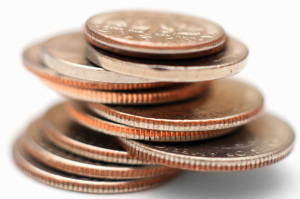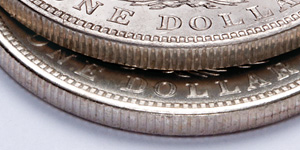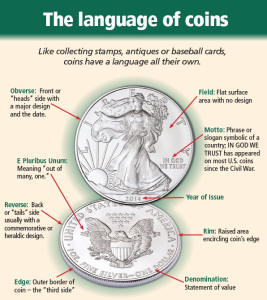“Reeded” edges on American coinage…
Some potato chips may have ridges,
but so do many United States coins!

Quarters and dimes have a “reeded” edge, while nickels and cents have a “plain” edge.
You may have noticed that the quarters and dimes in your pocket or purse have a “reeded” edge, featuring vertical grooves or ridges, while nickels and cents in your pocket have a “plain” or smooth edge. This is not by accident, though the purpose of reeding has evolved over the years…
To deter shaving of gold and silver coins
Reeded or ridged edges have been in use for a few centuries, and for many years were applied only to gold and silver coins – to discourage the filing or clipping of precious metal from the edges of coins. Edge shaving was a commonplace occurrence on plain-edged gold and silver coins during the 17th and 18th centuries, as unscrupulous individuals figured the next person to possess a coin would simply never notice it was slightly smaller and slightly lighter! Edge shaving on reeded coins was easily detected.
Reeding came into widespread use with the introduction of the collar die in semi- and fully-automatic coin presses during the late 1700s and 1800s. Encircling each coin blank as it came into the press, the collar die could bear an inscription or a design such as reeding. As the obverse and reverse dies came together with great force against a gold or silver coin blank in the press, metal from the coin blank would flow “outward” into the grooves of the reeded collar die.
Additional benefits of reeded edging
Though not the original purpose, reeding also made counterfeiting of coins much more difficult – requiring the skillful application of a third “vertical” design to a phony coin in addition to the obverse and reverse motifs (with that kind of talent, a counterfeiter could easily find lucrative legitimate work as a medalist or minter). Yet another advantage to reeded edges is that they give coins a more “finished” appearance and usually embellish the overall design and artistry of a coin. These benefits of counterfeiting deterrence and design enhancement have been enough to promote widespread use of reeded edges on coins made of base metals as well as those struck in precious metals like silver and gold.
The preferred edge for “pitching coins”
One other unintended advantage of reeded-edge coins was discovered during the Great Depression, when unemployed men would pitch pennies, nickels, dimes, quarters or even half dollars on the sidewalk to win a few coins or to relieve idle boredom. With the object being to land your coin closest to the building, some frequent participants found they could better grip and control the toss of reeded-edge coins! So they favored dime or quarter competitions featuring reeded-edge coins over penny or nickel tosses involving plain-edge coins. This aspect was of course never considered when reeding decisions were made at the U.S. Mint!
Reeded edging then and now
Reeded edges first appeared on U.S. coinage in the 1790s on half dimes, dimes and quarters struck in at least 89% silver, and on $2.50 gold quarter eagles, $5 gold half eagles and $10 gold eagles minted in at least 89% gold. The intention during those early years of the U.S. Mint was to thwart edge clipping or filing of precious metals from coins. That intention, along with design enhancement and counterfeiting deterrence, continues today with reeded edges found on silver and gold U.S. commemorative coins as well as silver and gold American Eagles. For design and counterfeiting considerations, reeded edges are also found on copper-nickel clad dimes, quarters and halves.
Serving a similar purpose to reeding, edge inscriptions are seen on the oldest U.S. half dollars and dollar coins struck in at least 89% fine silver. The edge on early 50¢ coins reads fifty cents or half a dollar, while the edge of early silver dollars is inscribed hundred cents one dollar or unit. Edge inscriptions including mottoes, dates of issue and mint marks are found on currently-issued Presidential and Native American dollars.
Prized varieties in reeded edging

Wide edge reeding on a small percentage of 1921 Morgan dollars features 157 reeds along the edge instead of the usual 189 reeds.
Experienced coin collectors always have an eye out for varieties of special interest, and there are even popular varieties in reeded edging. Our Buyer’s Choice in Littleton’s Spring 2014 Showcase offered the 1921 Morgan silver dollar with sought-after Wide Edge Reeding. This seldom-seen Morgan dollar variety features 157 reeds along the edge instead of the normal 189. So reeded edging has attained importance and prominence in the coin collecting hobby!
To learn more about the language of coins and terms like “reeded edges,” visit Littleton’s Learn Center.





I have a quarter where it seems that the sides are smooth but yet not completely smooth all the way around like the stamp did not close all the way if you know anything about this please let me know
Hi Cassey, If you can send us a couple of close up photos of the coin you’re talking about, we can have our coin graders take a look to see if they can tell what’s going on. You can send the photos to: info@littletoncoin.com Have a good day! -Rick
I found a dime that has a reeded edge and also a deeper face set 2018 p
Hi Littleton Coin: I have a 1965 Quarter that has a few strange cracks along the area between the edge of the coin and above the lettering “United States” as if the reeding is separating from the rest of the coin. Have you seen or heard of an error that results in the ribbed area (reeding?) coming off? It does not have the appearance of any tool marks or other intentional effort to separate the reeding. It rather appears to be an error in production to me…but I’m not an expert.
Hi Rach, we don’t do a whole lot with error coins, but if you can send us a couple of close up photos of your coin, I can have our graders take a look at it. Maybe they can give you some more info. You can send your photos to: info@littletoncoin.com. In the subject line, put “Attention:Rick”. Happy holidays! -Rick
I have a Georgia coin that has a band no ridges will not fit in laundry machine… reject
I have a 1999 D Georgia Quarter that is flat and smooth around the entire edge rim and is lighter weight also thicker.
Back in the day prison inmates would “tap” the edge of the coin with the back of a spoon. After a length of time and patience the band then was thick enough the center was drilled out to make a ring.
How many reeds are on the Eisenhower dollars
Good question Kurt! Unfortunately, I’ve never counted them, so sorry I don’t know.
I have a penny that has no ridge or edge and is the same size as a dime. I’ve been trying for a very, very, very, long time to find information on my penny. Can someone please help me or point me in the right direction please?
Hi Claudia, if you can take a couple of good clear photos of your penny (both sides) and email them to us, we can have our coin graders take a look to see what you have. You can send your photos to: info@littletoncoin.com. We look forward to hearing from you!
I have a nickel that is smooth all the way around has lip. Can’t see the year or writing around the coin it’s there but kind of cut off. And is smaller than a regular nickel.
If you can’t read the writing or the date, it sounds like your coin may be damaged or just worn down with age & circulation, Darlene. If you’d like to send us some photos via email, we can have our coin graders take a look at it if you want. You can email us at info@littletoncoin.com. Thanks for stopping by! Happy Thanksgiving!
I am interested in when silver dollars were first produced with Reese’s edges or if early silver dollars were all made with lettered edges.
Hi Richard, the first US Silver Dollar, with reeds on the edge would be the 1836-1839 Gobrecht Dollar, though some had reeds and some were plain. The US Mint added reeds to all Silver Dollars beginning in 1840.
The silver dollars with edge lettering were the 1794-1795 Flowing Hair Dollars & the 1795-1804 Draped Bust Dollars.
Thanks for stopping by!
I have a Connecticut 1788-1999 quarter it has the gold greenish look to it. It seem to me it also has the 5.9 and 6.3 grams of weight as well I’m not to sure about the edge reeding but I was wondering could I send you guys a few pictures if possible
Hi Robert, you can send your photos to info@littletoncoin.com. We can send them on to our coin graders so they can take a look & hopefully tell us what’s going on with your coin. We look forward to hearing from you!
Hello i have an 1804 reeded edge coin. I do know that it should have letters on the real coin but i cannot find any information on the reeded edge 1804 coin. Any advice?
Hi Billie, thanks for stopping by! My advice would be to find a local reputable coin dealer who can inspect the coin up close. They may be able to give you more information. If you’d like to send some photos to us, we can certainly have our graders take a look to see if they can shed some light on your interesting coin. You can email images to info@littletoncoin.com if you’d like.
I have a 1999 Georgia State Quarter with no reeding on the edge whatsoever. Although there is no reeding, there is a visible copper stripe on the edge and the quarter is slightly thicker than a normal one. The weight of it is roughly 5.7 grams. Is this quarter a special one? I cant seem to find any others except the ones on the golden planchets without the reeding. Any help would be greatly appreciated.
Hi Michael, thanks for stopping by. While we may occasionally obtain, and offer a specific error coin — unfortunately, we are not error coin specialists.
We recommend contacting a local reputable coin dealer who can inspect your coin up close to determine if it’s a true error coin or perhaps just post-mint damage. They can likely help you find out the value of your coin. Best of luck!